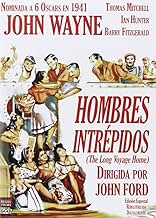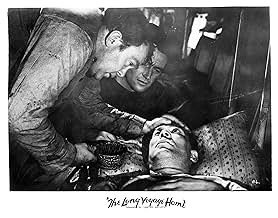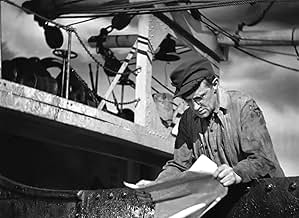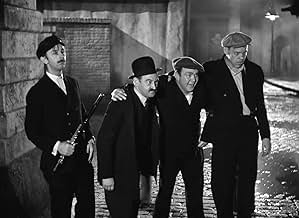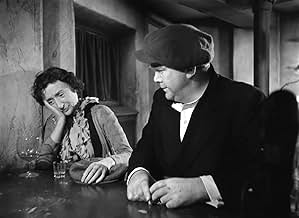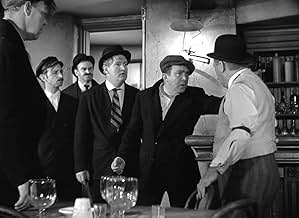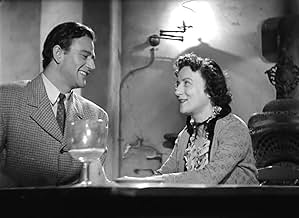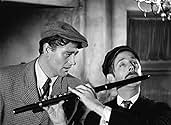IMDb RATING
6.9/10
5.3K
YOUR RATING
A merchant ship's crew tries to survive the loneliness of the sea and the coming of war.A merchant ship's crew tries to survive the loneliness of the sea and the coming of war.A merchant ship's crew tries to survive the loneliness of the sea and the coming of war.
- Nominated for 6 Oscars
- 8 wins & 7 nominations total
Wilfrid Lawson
- Captain
- (as Wilfred Lawson)
Joe Sawyer
- Davis
- (as Joseph Sawyer)
Constant Franke
- Norway
- (as Constant Frenke)
David Hillary Hughes
- Scotty
- (as David Hughes)
- Director
- Writers
- All cast & crew
- Production, box office & more at IMDbPro
Featured reviews
John Wayne is misleadingly top-billed ,presumably to bring in the crowds who thought they were going to see typical Wayne heroics in this one.He is actually part of an excellent ensemble cast in this film,which has seamlessly adapted by Dudley Nichols from a group of one-act plays by the great Eugene O'Neill. Nichols' writing is so good that unless you're an O'Neill expert,it is VERY difficult to tell where O'Neill leaves off and Nichols takes over,except perhaps in the episode involving British actor Ian Hunter (in the performance of a lifetime) as a presumed German spy. The plays,written in the early 1900's,have been updated to take place during WW II,but the propaganda angle is very tastefully handled and almost non-existent;in fact,here Nichols and director John Ford show great respect for the integrity of O'Neill's plays.
The cast is excellent,but Wayne actually hasn't got much to do in comparison with his other films,and this is a film of dialogue,not action.Perhaps that's why the previous reviewer found it interminable. [John Wayne uses a Swedish (!) accent in this movie,which he actually does quite well--don't laugh!] The most intense acting is done by Thomas Mitchell (Scarlett O'Hara's dad in "Gone With The Wind") and Barry Fitzgerald,who are actually the stars of the movie.And director John Ford shows us what a true master of his craft he is by equalling Hitchcock's accomplishment in "Lifeboat" in keeping the action confined to a small space without making it seem tiresome. The back-and-white photography is stunningly good--the best American photography in a black-and-white 1940's American film,aside from "Citizen Kane",of course.
John Wayne fans shouldn't pass this one up,and all non-fans should still enjoy this fine film.
The cast is excellent,but Wayne actually hasn't got much to do in comparison with his other films,and this is a film of dialogue,not action.Perhaps that's why the previous reviewer found it interminable. [John Wayne uses a Swedish (!) accent in this movie,which he actually does quite well--don't laugh!] The most intense acting is done by Thomas Mitchell (Scarlett O'Hara's dad in "Gone With The Wind") and Barry Fitzgerald,who are actually the stars of the movie.And director John Ford shows us what a true master of his craft he is by equalling Hitchcock's accomplishment in "Lifeboat" in keeping the action confined to a small space without making it seem tiresome. The back-and-white photography is stunningly good--the best American photography in a black-and-white 1940's American film,aside from "Citizen Kane",of course.
John Wayne fans shouldn't pass this one up,and all non-fans should still enjoy this fine film.
I was expecting this film about a tramp steamer with a cargo of high explosives to be a wartime drama along the lines of "San Demetrio"; in fact, the war is pretty peripheral. Even when the ship does come under attack, somewhere around the middle of the picture, she apparently escapes unscathed via means unspecified (did the enemy simply run out of bombs after missing with all of them?) It's really a story about life on the lower decks, with the officers making distant appearances and the wartime background intruding from time to time, but with the main focus on the relationships among the crew.
According to the credits, it was adapted from a set of "sea plays" by Eugene O'Neill, which accounts for the very episodic feel of the film. It's not really a complete story; it's a set of individual isolated incidents, some of which are never really explained (all the signalling with torches, for instance, which is apparently not anything to do with undercover spies -- I actually assumed there were two ships in the opening scene, one being the tramp steamer and the other a British naval vessel!) On the other hand, it did succeed in several places in making me care about the characters; I was convinced that Smitty was being falsely accused, and desperate by the end for Ole to escape successfully from seaboard life as his shipmates are determined that he should do, despite the heavy foreshadowing otherwise.
The film was billed as "John Wayne in Eugene O'Neill's The Long Voyage Home", but that's presumably a retrospective attempt to cash in on Wayne's name; the lead actors are Thomas Mitchell as the burly Irishman Driscoll, and Ian Hunter as the middle-class Englishman who is the odd one out among his cheery companions. John Wayne plays Ole, the simple Swedish farmboy whose role is largely passive and monosyllabic, though he gets a good scene where he talks nostalgically about his home during the final drunken bar-crawl.
There are no very great surprises here, and the pace is quite slow -- extremely slow at the beginning, which is presumably intended to indicate the heat and tedium of a tropical night. I can see these individual 'episodes' working better in the original format as one-act plays, each with its definitive ending, than as an attempt at one continuing story. I didn't find the film quite successful (not nearly so much so as the English production "San Demetrio, London"), but on the other hand, it's not entirely mediocre -- and it's not as gung-ho as an actual war film would probably have been. (The shadowy role of the war is explained, in retrospect, by the fact that the source material was written twenty years earlier!)
I'd probably rate it 7/10: worth taping from TV, not worth paying for :-p
According to the credits, it was adapted from a set of "sea plays" by Eugene O'Neill, which accounts for the very episodic feel of the film. It's not really a complete story; it's a set of individual isolated incidents, some of which are never really explained (all the signalling with torches, for instance, which is apparently not anything to do with undercover spies -- I actually assumed there were two ships in the opening scene, one being the tramp steamer and the other a British naval vessel!) On the other hand, it did succeed in several places in making me care about the characters; I was convinced that Smitty was being falsely accused, and desperate by the end for Ole to escape successfully from seaboard life as his shipmates are determined that he should do, despite the heavy foreshadowing otherwise.
The film was billed as "John Wayne in Eugene O'Neill's The Long Voyage Home", but that's presumably a retrospective attempt to cash in on Wayne's name; the lead actors are Thomas Mitchell as the burly Irishman Driscoll, and Ian Hunter as the middle-class Englishman who is the odd one out among his cheery companions. John Wayne plays Ole, the simple Swedish farmboy whose role is largely passive and monosyllabic, though he gets a good scene where he talks nostalgically about his home during the final drunken bar-crawl.
There are no very great surprises here, and the pace is quite slow -- extremely slow at the beginning, which is presumably intended to indicate the heat and tedium of a tropical night. I can see these individual 'episodes' working better in the original format as one-act plays, each with its definitive ending, than as an attempt at one continuing story. I didn't find the film quite successful (not nearly so much so as the English production "San Demetrio, London"), but on the other hand, it's not entirely mediocre -- and it's not as gung-ho as an actual war film would probably have been. (The shadowy role of the war is explained, in retrospect, by the fact that the source material was written twenty years earlier!)
I'd probably rate it 7/10: worth taping from TV, not worth paying for :-p
Dark in tone, primarily enclosed on sound-stage, no major stars -- and Eugene O'Neill not an easy transfer from stage to screen -- this project does not have much working in its favour. But there's a great team at work here -- cameraman Gregg Toland, writer Dudley Nichols, director John Ford -- and an Irish-inflected ensemble, much like a troupe of players transported from Dublin's Abbey Theatre.
The Long Voyage Home compresses four short O'Neill plays into a single narrative, updated from World War I to the onset of World War II. The plays have been softened in language, and the overriding doom-and despair motif is lightened with bits of Irish-style shenanigans. Still, the considerable fidelity to O'Neill's text is one of the pleasures of viewing.
We are seldom outside the studio soundstage, but even with process shots and projections, the filmmakers still create the illusion of the open sea. The storm sequences have considerable impact, even for the contemporary viewer. Some sequences here are worthy of Ford's earlier spectacle The Hurricane, albeit on a smaller scale.
Toland's striking camerawork, with its deep focus and Expressionist lighting, gives the film a foreboding, unsettling quality, well suited to the precarious nature of the wartime voyage from the West Indies to England.
There's a likeable interplay among the actors. I get a bit tired of John Quelan with his whining falsetto brogue, and to an extent smart aleck Barry Fitzgerald with his supercilious chin. But I engage easily with Thomas Mitchell's bossy, streetwise good nature, and especially Ward Bond, who, contrary to his usual gruff, rough-edged manner, gets some soulful moments as the unlucky sailor named Yank.
Youthful John Wayne is surprisingly right as the Swedish sailor on his long voyage home, perhaps the pivotal member of this crew, attached to one another for better or for worse. He and dockside bar-maid Mildred Natwick share a few poignant moments in the last part of the film.
From a modern perspective, some sentiments and attitudes are incorrectly expressed, but in the period, Long Voyage Home admirably gives O'Neill a measure of 'realism' and respect from Hollywood. It is the only O'Neill film to be nominated for a Best Picture Oscar (and 5 other awards).
The Long Voyage Home compresses four short O'Neill plays into a single narrative, updated from World War I to the onset of World War II. The plays have been softened in language, and the overriding doom-and despair motif is lightened with bits of Irish-style shenanigans. Still, the considerable fidelity to O'Neill's text is one of the pleasures of viewing.
We are seldom outside the studio soundstage, but even with process shots and projections, the filmmakers still create the illusion of the open sea. The storm sequences have considerable impact, even for the contemporary viewer. Some sequences here are worthy of Ford's earlier spectacle The Hurricane, albeit on a smaller scale.
Toland's striking camerawork, with its deep focus and Expressionist lighting, gives the film a foreboding, unsettling quality, well suited to the precarious nature of the wartime voyage from the West Indies to England.
There's a likeable interplay among the actors. I get a bit tired of John Quelan with his whining falsetto brogue, and to an extent smart aleck Barry Fitzgerald with his supercilious chin. But I engage easily with Thomas Mitchell's bossy, streetwise good nature, and especially Ward Bond, who, contrary to his usual gruff, rough-edged manner, gets some soulful moments as the unlucky sailor named Yank.
Youthful John Wayne is surprisingly right as the Swedish sailor on his long voyage home, perhaps the pivotal member of this crew, attached to one another for better or for worse. He and dockside bar-maid Mildred Natwick share a few poignant moments in the last part of the film.
From a modern perspective, some sentiments and attitudes are incorrectly expressed, but in the period, Long Voyage Home admirably gives O'Neill a measure of 'realism' and respect from Hollywood. It is the only O'Neill film to be nominated for a Best Picture Oscar (and 5 other awards).
The talented cast acts this excellent screen rendition of Eugene O'Neill's play (it's adapted from three of his one-act plays) about crew sailors aboard a freighter steamer called ¨Glencairn¨ carrying charge containing war-smuggling , TNT , explosives from US to England , at the beginning WWII . This film's opening prologue states : "With their hates and desires men are changing the face of the earth - but they cannot change the Sea . Men who live on the Sea never change - for they live in a lonely world apart as they drift from one rusty tramp steamer to the next, forging the life of Nations" . The crew talk themselves and contend each other , but also save each other from bombing and risks . At the ending terminates with an epilogue that states : 'Some men like Ole and the Driscolls come a and go and the others live and die and the Yanks and Smittys leave their memories- but for the others the long voyage never ends' .
This dramatic film is a classic Ford , displaying his usual themes as strong issues in many films , such as emotionalism , partnership , friendship and unlovable camaraderie between the sailors . However , it seems to be sometimes excessively sentimental and looks over-melodramatic during the reading letters from Smittys . The sailors show a nostalgic longing for past things and old values and their own homes : Sweden , Ireland , England . Straightforward acting by John Wayne as a Swedish sailor named Ole , he was to star habitually for Ford after the director rose his career from B Western in ¨Poverty Row¨ productions , with his greatest hit , 'Stagecoach' . There's magnificent secondary cast playing the seamen , as Thomas Mitchell as a sympathetic sailor , Ian Hunter as the drunk and unbalanced Smittys , Mildred Natwick as a swindler prostitute , Rafaela Ottiano as a tropical woman , Jack Pennick , a Ford's usual , among others . Barry FitzGerald , who plays the character of humorous cook ¨Cocky¨ , and Arthur Shields, who played Donkeyman , were brothers in real life . They also appeared together in director John Ford's The quiet man (1952).
Descriptive , evocative black-and-white cinematography by Gregg Toland (Citizen Kane) , plenty of lights and shades , reflecting loneliness , dark suspicion , frightening from crew and the smoky , greasy , sweaty atmosphere from merchant ship . Cinematographer Gregg Toland's photographing of this movie utilized high contrast lighting . The picture belongs the best period when John Ford (1895-1973) made a rich variety of stories and his reputation rightly rests on his work in the 1940s , as ¨Grapes of wrath¨ , ¨How green was my valley¨ , ¨Fugitive¨ , ¨They were expendable¨ , ¨My darling Clementine¨ and the Cavalry trilogy : ¨Fort Apache¨ , ¨She wore a yellow ribbon¨ , ¨Rio Grande¨. Rating : Awesome , above average , a major triumph for Ford and Wayne . It's a must see from John Ford enthusiasts and John Wayne fans.
This dramatic film is a classic Ford , displaying his usual themes as strong issues in many films , such as emotionalism , partnership , friendship and unlovable camaraderie between the sailors . However , it seems to be sometimes excessively sentimental and looks over-melodramatic during the reading letters from Smittys . The sailors show a nostalgic longing for past things and old values and their own homes : Sweden , Ireland , England . Straightforward acting by John Wayne as a Swedish sailor named Ole , he was to star habitually for Ford after the director rose his career from B Western in ¨Poverty Row¨ productions , with his greatest hit , 'Stagecoach' . There's magnificent secondary cast playing the seamen , as Thomas Mitchell as a sympathetic sailor , Ian Hunter as the drunk and unbalanced Smittys , Mildred Natwick as a swindler prostitute , Rafaela Ottiano as a tropical woman , Jack Pennick , a Ford's usual , among others . Barry FitzGerald , who plays the character of humorous cook ¨Cocky¨ , and Arthur Shields, who played Donkeyman , were brothers in real life . They also appeared together in director John Ford's The quiet man (1952).
Descriptive , evocative black-and-white cinematography by Gregg Toland (Citizen Kane) , plenty of lights and shades , reflecting loneliness , dark suspicion , frightening from crew and the smoky , greasy , sweaty atmosphere from merchant ship . Cinematographer Gregg Toland's photographing of this movie utilized high contrast lighting . The picture belongs the best period when John Ford (1895-1973) made a rich variety of stories and his reputation rightly rests on his work in the 1940s , as ¨Grapes of wrath¨ , ¨How green was my valley¨ , ¨Fugitive¨ , ¨They were expendable¨ , ¨My darling Clementine¨ and the Cavalry trilogy : ¨Fort Apache¨ , ¨She wore a yellow ribbon¨ , ¨Rio Grande¨. Rating : Awesome , above average , a major triumph for Ford and Wayne . It's a must see from John Ford enthusiasts and John Wayne fans.
The Long Voyage Home is a compilation film of four one act plays by Eugene O'Neill who some will argue is America's greatest dramatist. The man who did the stitching together of O'Neill's work about the crew of the S.S. Glencairn is Dudley Nichols and presiding over it all is the direction of John Ford.
Mr. Ford is usually someone who really puts an individual stamp on one of his movies. But the usual Ford trademarks are noticeably absent from The Long Voyage Home. Probably in mood and style the film of Ford's this comes closest to is The Informer. In fact J.M. Kerrigan is playing almost the same part in this as he did in The Informer.
One thing Ford always did was use the right kind of music to set the tone for a film. Those 19th century ballads like I Dream of Jeannie that work so well in something like Stagecoach are substituted for Harbor Lights. That song expresses so well the longing of a whole bunch of rootless men to find some kind of stability in their lives.
Eugene O'Neill spent many years at sea and the characters of these men on the S.S. Glencairn are drawn from his own youthful experience. Most of our planet is covered by water and no country owns it. It's just called the high seas and the seamen on it are an international fraternity, like the S.S. Glencairn crew. I've always felt that O'Neill was trying to say that if there's any salvation to be had in this old world, it's to be found on the salt water. It's the only place where all kinds of people really work for a common goal, stay alive and make the trip.
The original plays had a World War I background, but it has been updated for World War II. Especially in the part when the crew becomes convinced that Ian Hunter is some kind of spy. Certainly the second World War in 1940 gave the audiences some real interest. Ian Hunter may have given his career performance in this as Smitty. Turns out he's far from what everyone suspects.
Hard to believe that John Wayne would be in a film by one of our greatest dramatists. But the Duke holds his own in the ensemble. It's the only time he ever attempted some kind of accent and he pulls it off. But I'm sure he thought once was enough.
Wayne as Olsen is the innocent of the group, maybe the only time he's ever been that on the screen. The rest of the crew makes every effort to see he does in fact get home to Sweden. It turns out to cost one of them his life ultimately.
If you're any kind of depressed, The Long Voyage Home or any Eugene O'Neill is not good for your mental health. He's one pessimistic fellow that O'Neill. But his insights into our character and soul are always penetrating as they are in The Long Voyage Home.
Mr. Ford is usually someone who really puts an individual stamp on one of his movies. But the usual Ford trademarks are noticeably absent from The Long Voyage Home. Probably in mood and style the film of Ford's this comes closest to is The Informer. In fact J.M. Kerrigan is playing almost the same part in this as he did in The Informer.
One thing Ford always did was use the right kind of music to set the tone for a film. Those 19th century ballads like I Dream of Jeannie that work so well in something like Stagecoach are substituted for Harbor Lights. That song expresses so well the longing of a whole bunch of rootless men to find some kind of stability in their lives.
Eugene O'Neill spent many years at sea and the characters of these men on the S.S. Glencairn are drawn from his own youthful experience. Most of our planet is covered by water and no country owns it. It's just called the high seas and the seamen on it are an international fraternity, like the S.S. Glencairn crew. I've always felt that O'Neill was trying to say that if there's any salvation to be had in this old world, it's to be found on the salt water. It's the only place where all kinds of people really work for a common goal, stay alive and make the trip.
The original plays had a World War I background, but it has been updated for World War II. Especially in the part when the crew becomes convinced that Ian Hunter is some kind of spy. Certainly the second World War in 1940 gave the audiences some real interest. Ian Hunter may have given his career performance in this as Smitty. Turns out he's far from what everyone suspects.
Hard to believe that John Wayne would be in a film by one of our greatest dramatists. But the Duke holds his own in the ensemble. It's the only time he ever attempted some kind of accent and he pulls it off. But I'm sure he thought once was enough.
Wayne as Olsen is the innocent of the group, maybe the only time he's ever been that on the screen. The rest of the crew makes every effort to see he does in fact get home to Sweden. It turns out to cost one of them his life ultimately.
If you're any kind of depressed, The Long Voyage Home or any Eugene O'Neill is not good for your mental health. He's one pessimistic fellow that O'Neill. But his insights into our character and soul are always penetrating as they are in The Long Voyage Home.
Did you know
- TriviaBarry Fitzgerald, who plays the character of Cocky, and Arthur Shields, who played Donkeyman, were brothers in real life. They also appeared together in director John Ford's L'homme tranquille (1952).
- GoofsAt the beginning of the film, when Driscoll sneaks back to the ship, he jumps from a rowboat into the water and climbs up the anchor chain. The next time onscreen, he appears dry from head to toe.
- ConnectionsFeatured in Film Preview: Episode #1.2 (1966)
- SoundtracksBlow the Man Down
(uncredited)
Traditional
Played during the opening credits
Sung often by crewmen
Sung a cappella by J.M. Kerrigan
Variations played as part of the score
- How long is The Long Voyage Home?Powered by Alexa
Details
- Release date
- Country of origin
- Languages
- Also known as
- Le Long Voyage
- Filming locations
- Los Angeles Harbor, Wilmington, Los Angeles, California, USA(scenes on S.S. Munami)
- Production companies
- See more company credits at IMDbPro
Box office
- Budget
- $682,495 (estimated)
- Runtime1 hour 45 minutes
- Color
- Aspect ratio
- 1.37 : 1
Contribute to this page
Suggest an edit or add missing content

